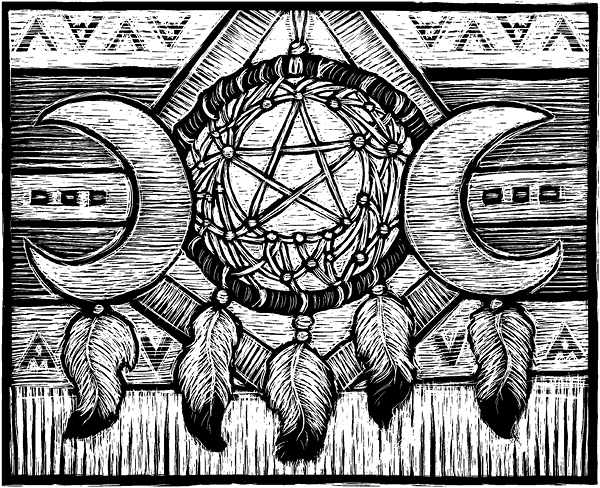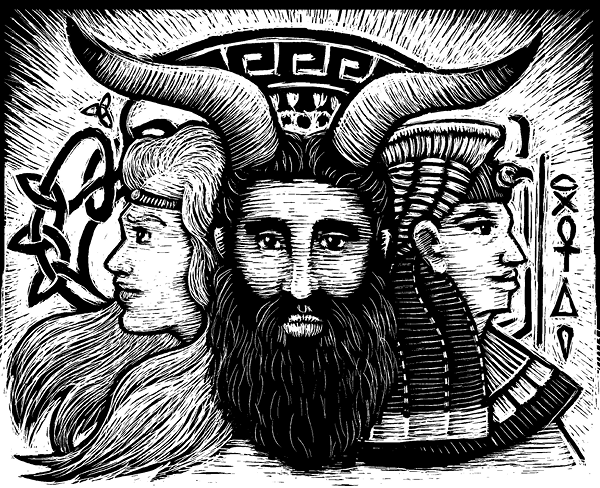Worshipping Widely and
Cultural Appropriation
Deborah Blake
When I was a kid, maybe nine or ten or so, I went through a period of time when I thought Native Americans were incredibly cool. They are, of course—just not in the simplistic way I looked at them back then. Mind you, when I was studying them in school, they were still referred to as Indians, so that gives you some idea of how long ago it was. My point is, I was so enamored with their culture that I spent the better part of a year wearing my long dark-brown hair in braids and telling everyone I was Native American. That, alas, was not so cool. Still, I was nine. I can probably be excused.
These days, we’d call that cultural appropriation. And unless you’re nine, someone is probably going to call you on it sooner or later.

Cultural appropriation, at its most basic level, is when someone adopts aspects of a culture that is not their own. The concept is considerably more complicated than that, however, and has special relevance when it comes to modern Witchcraft and Neopaganism, in which many of us follow a path that strays far from our own origins. Can we worship deities and integrate practices not from our particular cultural background without it becoming cultural appropriation?
While there are those who might disagree with me, I would argue that it is almost impossible not to use parts of other cultures in a modern Witchcraft practice, at least for some of us, and it all comes down to attitude and approach.
One very simple example is the use of sage smudge sticks for cleansing and clearing the energy of a person and/or space. This is a practice adapted from Native American roots, and yet it is now an integral part of many magical and spiritual rites. I use it on a regular basis just to clear away the “sludge” of daily life, and it is how my group, Blue Moon Circle, has started every ritual we’ve done together for over a dozen years. I can’t imagine not using sage. But if you want to get technical, this practice could be considered cultural appropriation.

A much more complicated issue concerns deity/deities. For many, modern Witchcraft is a polytheistic religion, involving the worship of more than one god/goddess, often from more than one culture. Over the years, Blue Moon Circle has consisted of a number of different women who worship different deities. Sometimes we use the general term “God and Goddess” when invoking deity in circle, and sometimes, depending on the sabbat, the time of year, who is leading the ritual, or the intent of whichever spell we are working, we might call on someone specific. Brigid and Hecate and Demeter, the Horned God and Apollo … they have all been called upon in turn. Hecate, in particular, is my patron goddess, the one who called to me the loudest.
None of them are the gods or goddesses from my culture of origin.
You see, I was brought up Jewish. And while I am very proud of my Jewish heritage, I never connected with the patriarchal god figure of my youth. But in theory, if I were to avoid any issues of cultural appropriation, I would be limited to worshipping that god (sorry … God). There was only one. And you have to go really far back to find anything resembling a goddess figure.
Some folks might say, “Well, your people were Russian Jews and Polish Jews, so you should stick to the gods from those cultures.” The problem with this argument is that the Jews were never considered to be part of those cultures, even if they might have worn the same clothes or cooked some of the same foods as their neighbors. So if I’m not allowed to worship a deity from outside of the culture I was born into, I’m kind of stuck with that One God.
And no insult to the folks for whom that works, but I really needed to connect with Goddess. Lots of goddesses, and a few gods, but most especially with Hecate.
She’s another interesting example of how difficult it can be to stick to one particular culture. Most people think of Hecate (or Hekate) as a Greek goddess, but she probably originated in Anatolia, a part of Asia Minor located in Turkey. She was worshipped by the Egyptians and Romans and in much of Europe throughout the centuries. So does she belong to only one culture or many? Was it cultural appropriation when her worship spread across the continents? Is it okay to worship her now if you have ties to any of those cultures, or only with the Greek? Or the Turkish (if we want to get really technical)?
Many of the gods and goddesses held sacred by modern Witches have the same kind of multicultural span. Almost all of the Greek gods have Roman counterparts. Isis was worshipped not just in Egypt but also as far away as East Africa and into Western Asia and Europe. Whose culture does she belong to?
Of course, our connection to individual gods and goddesses often goes far beyond the issue of whether or not we follow a particular pantheon, such as Greek, Egyptian, or Celtic. For most of us, it was less a matter of choosing a god or goddess to address our prayers to than it was the realization that they had chosen us. If a god or goddess calls our name, should we ignore them because the culture they originated in is not the same as our own?
For most of us, it was less a matter of choosing a god or goddess to address our prayers to than it was the realization that they had chosen us. If a god or goddess calls our name, should we ignore them because the culture they originated in is not the same as our own?
I don’t know about you, but I don’t particularly want to explain that to Hecate. Something tells me it wouldn’t go over well. Is it more disrespectful to use aspects of a culture not our own or to turn our backs on the sacred elements that call to our hearts and spirits? These are tough questions, and each of us must find the answers that are right for us.
One of the characteristics of modern Witchcraft that appealed to me the most was how open and flexible it was. I’d tried a number of different paths—Judaism, Unitarian Universalism, Buddhism, and Taoism—and nothing really resonated with me until I stood in my first magic circle, on Samhain, no less, and finally felt Someone reaching back when I reached out. On that night, God and Goddess didn’t have a name; I just knew them for what they were. Later, after I’d studied and practiced extensively, I was able to pick and choose those aspects of an eclectic Witchcraft practice that worked the best for me.
Practicing Witchcraft changed my life forever, and much for the better, but none of those aspects came from my original cultural background. Not one.
This isn’t something I ignore, nor do I take it for granted. Rather, I am fully aware of and grateful for the cultures whose beliefs and tools I have borrowed. I treat all my adopted practices with respect and would not use anything if I thought that doing so would in any way harm the original culture from which it came.
In short, I am not taking away from, but rather, I hope, adding to the great range of the human magical experience. While it is certainly true that there are those in the modern Witchcraft world who do not take their practice seriously, or whose use of pieces from other cultures is thoughtless or disrespectful, I don’t believe that is the norm.
I think for most of us these gifts from other cultures are seen not as other, but rather as part of our shared magical heritage, no matter what our culture of origin might be. A friend of mine, a White woman, was called by Yemaya, an African goddess. This might seem odd to those who don’t understand the strange ways that deity can move in our lives, but for her, it is not cultural appropriation; it is her faith. It is the path that the goddess herself invited her to walk.
This, for me, is at the very heart of this argument, when you ask if the practice of modern Witchcraft, with its use of so many gods and beliefs and tools of other cultures, is guilty of cultural appropriation. Certainly, in some cases and with some people, that is probably the case. But for most of us, we are simply listening to the gods when they whisper in our ears, and following our hearts down the paths that lead to our spiritual growth and happiness.
There is no careless theft here, not even the kind that a nine-year-old might unintentionally indulge in. There is respect and worship and faith, and in all the best possible ways there is a mingling of many cultures as we come together to celebrate that which has guided the human spirit for centuries.
Deborah Blake is the award-winning author of The Goddess Is in the Details, Everyday Witchcraft, and numerous other books from Llewellyn. She has published many articles in Llewellyn annuals, and her ongoing column, “Everyday Witchcraft,” is featured in Witches & Pagans magazine. Deborah is also the author of the paranormal romance Baba Yaga series from Berkley Publishing, as well as the Veiled Magic urban fantasies. Deborah can be found online at Facebook, Twitter, and www.deborahblakeauthor.com. She lives in a 130-year-old farmhouse in rural upstate New York with numerous cats who supervise all her activities, both magickal and mundane.
Illustrator: Bri Hermanson